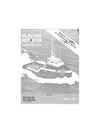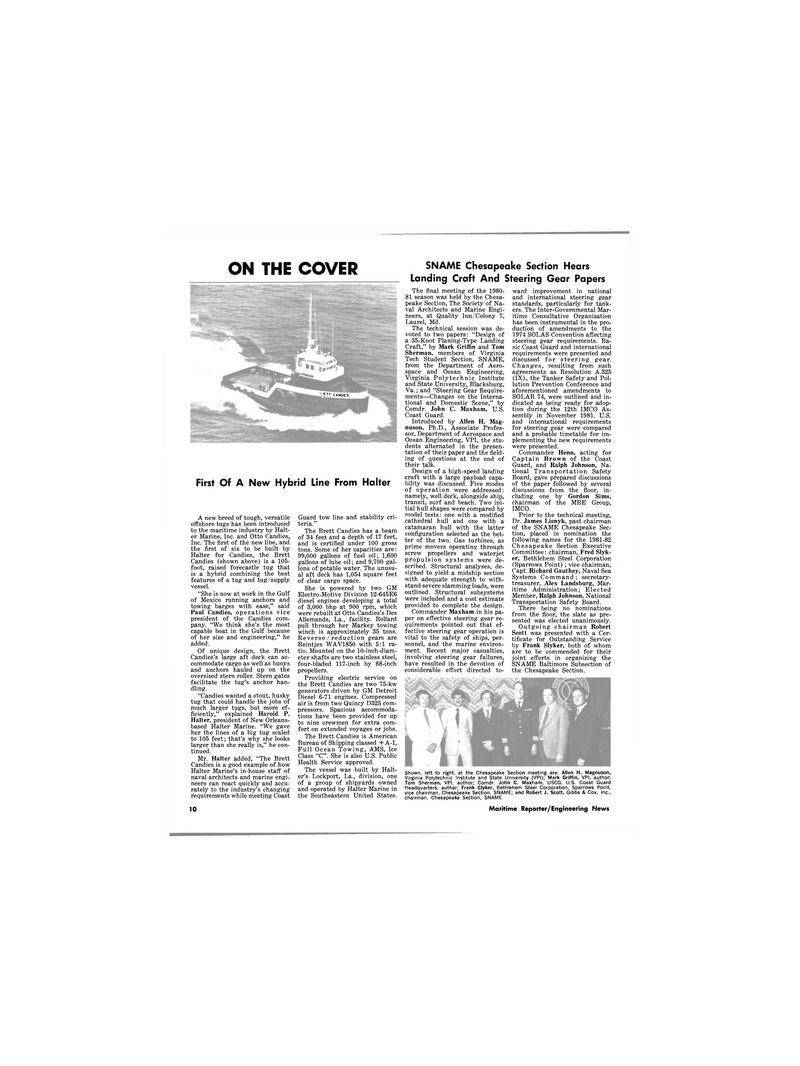
Page 8: of Maritime Reporter Magazine (August 1981)
Read this page in Pdf, Flash or Html5 edition of August 1981 Maritime Reporter Magazine
SNAME Chesapeake Section Hears
Landing Craft And Steering Gear Papers ON THE COVER
First Of A New Hybrid Line From Halter
A new breed of tough, versatile offshore tugs has been introduced to the maritime industry by Halt- er Marine, Inc. and Otto Candies,
Inc. The first of the new line, and the first of six to be built by
Halter for Candies, the Brett
Candies (shown above) is a 105- foot, raised forecastle tug that is a hybrid combining the best features of a tug and tug/supply vessel. "She is now at work in the Gulf of Mexico running anchors and towing barges with ease," said
Paul Candies, operations vice president of the Candies com- pany. "We think she's the most capable boat in the Gulf because of her size and engineering," he added.
Of unique design, the Brett
Candies's large aft deck can ac- commodate cargo as well as buoys and anchors hauled up on the oversized stern roller. Stern gates facilitate the tug's anchor han- dling. "Candies wanted a stout, husky tug that could handle the jobs of much larger tugs, but more ef- ficiently," explained Harold P.
Halter, president of New Orleans- based Halter Marine. "We gave her the lines of a big tug scaled to 105 feet; that's why she looks larger than she really is," he con- tinued.
Mr. Halter added, "The Brett
Candies is a good example of how
Halter Marine's in-house staff of naval architects and marine engi- neers can react quickly and accu- rately to the industry's changing requirements while meeting Coast
Guard tow line and stability cri- teria."
The Brett Candies has a beam of 34 feet and a depth of 17 feet, and is certified under 100 gross tons. Some of her capacities are: 99,000 gallons of fuel oil; 1,600 gallons of lube oil; and 9,700 gal- lons of potable water. The unusu- al aft deck has 1,054 square feet of clear cargo space.
She is powered by two GM
Electro-Motive Division 12-645E6 diesel engines developing a total of 3,000 bhp at 900 rpm, which were rebuilt at Otto Candies's Des
Allemands, La., facility. Bollard pull through her Markey towing winch is approximately 35 tons.
Reverse /reduction gears are
Reintjes WAY1850 with 5:1 ra- tio. Mounted on the 10-inch-diam- eter shafts are two stainless steel, four-bladed 117-inch by 88-inch propellers.
Providing electric service on the Brett Candies are two 75-kw generators driven by GM Detroit
Diesel 6-71 engines. Compressed air is from two Quincy D325 com- pressors. Spacious accommoda- tions have been provided for up to nine crewmen for extra com- fort on extended voyages or jobs.
The Brett Candies is American
Bureau of Shipping classed 4-A-l,
Full Ocean Towing, AMS, Ice
Class "C". She is also U.S. Public
Health Service approved.
The vessel was built by Halt- er's Lockport, La., division, one of a group of shipyards owned and operated by Halter Marine in the Southeastern United States.
The final meeting of the 1980- 81 season was held by the Chesa- peake Section, The Society of Na- val Architects and Marine Engi- neers, at Quality Inn/Colony 7,
Laurel, Md.
The technical session was de- voted to two papers: "Design of a 35-Knot Planing-Tvpe Landing
Craft," by Mark Griffin and Tom
Sherman, members of Virginia
Tech Student Section, SNAME, from the Department of Aero- space and Ocean Engineering,
Virginia Polytechnic Institute and State University, Blacksburg,
Va.; and "Steering Gear Require- ments—Changes on the Interna- tional and Domestic Scene," by
Comdr. John C. Maxham, U.S.
Coast Guard.
Introduced by Allen H. Mag- nuson, Ph.D., Associate Profes- sor, Department of Aerospace and
Ocean Engineering, VPI, the stu- dents alternated in the presen- tation of their paper and the field- ing of questions at the end of their talk.
Design of a high-speed landing craft with a large payload capa- bility was discussed. Five modes of operation were addressed: namely, well deck, alongside ship, transit, surf and beach. Two ini- tial hull shapes were compared by model tests: one with a modified cathedral hull and one with a catamaran hull with the latter configuration selected as the bet- ter of the two. Gas turbines, as prime movers operating through screw propellers and waterjet propulsion systems were de- scribed. Structural analyses, de- signed to yield a midship section with adequate strength to with- stand severe slamming loads, were outlined. Structural subsystems were included and a cost estimate provided to complete the design.
Commander Maxham in his pa- per on effective steering gear re- quirements pointed out that ef- fective steering gear operation is vital to the safety of ships, per- sonnel, and the marine environ- ment. Recent major casualties, involving steering gear failures, have resulted in the devotion of considerable effort directed to- ward improvement in national and international steering gear standards, particularly for tank- ers. The Inter-Governmental Mar- itime Consultative Organization has been instrumental in the pro- duction of amendments to the 1974 SOLAS Convention affecting steering gear requirements. Ba- sic Coast Guard and international requirements were presented and discussed for steering gear.
Changes, resulting from such agreements as Resolution A.325 (IX), the Tanker Safety and Pol- lution Prevention Conference and aforementioned amendments to
SOLAR 74, were outlined and in- dicated as being ready for adop- tion during the 12th IMCO As- sembly in November 1981. U.S. and international requirements for steering gear were compared and a probable timetable for im- plementing the new requirements were presented.
Commander Henn, acting for
Captain Brown of the Coast
Guard, and Ralph Johnson, Na- tional Transportation Safety
Board, gave prepared discussions of the paper followed by several discussions from the floor, in- cluding one by Gordon Sims, chairman of the MBE Group,
IMCO.
Prior to the technical meeting,
Dr. James Lisnyk, past chairman of the SNAME Chesapeake Sec- tion, placed in nomination the following names for the 1981-82
Chesapeake Section Executive
Committee: chairman, Fred Slyk- er, Bethlehem Steel Corporation (Sparrows Point) ; vice chairman,
Capt. Richard Gauthey, Naval Sea
Systems Command ; secretary- treasurer, Alex Landsburg, Mar- itime Administration; Elected
Member, Ralph Johnson, National
Transportation Safety Board.
There being no nominations from the floor, the slate as pre- sented was elected unanimously.
Outgoing chairman Robert
Scott was presented with a Cer- tificate for Outstanding Service by Frank Slyker, both of whom are to be commended for their joint efforts in organizing the
SNAME Baltimore Subsection of the Chesapeake Section.
Shown, left to right, at the Chesapeake Section meeting are: Allen H. Magnuson,
Virginia Polytechnic Institute and State University (VPI); Mark Griffin, VPI, author;
Tom Sherman, VPI, author; Comdr. John C. Maxham, USCG, U.S. Coast Guard
Headquarters, author; Frank Clyker, Bethlehem Steel Corporation, Sparrows Point, vice chairman, Chesapeake Section, SNAME; and Robert J. Scott, Gibbs & Cox, Inc., chairman, Chesapeake Section, SNAME. 1£tt candies 10 Maritime Reporter/Engineering News

 7
7

 9
9
